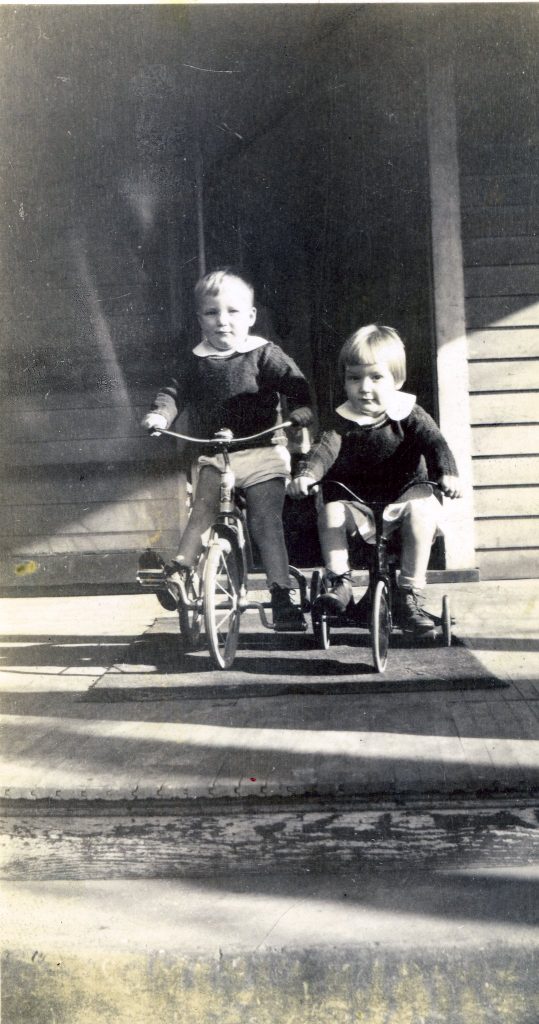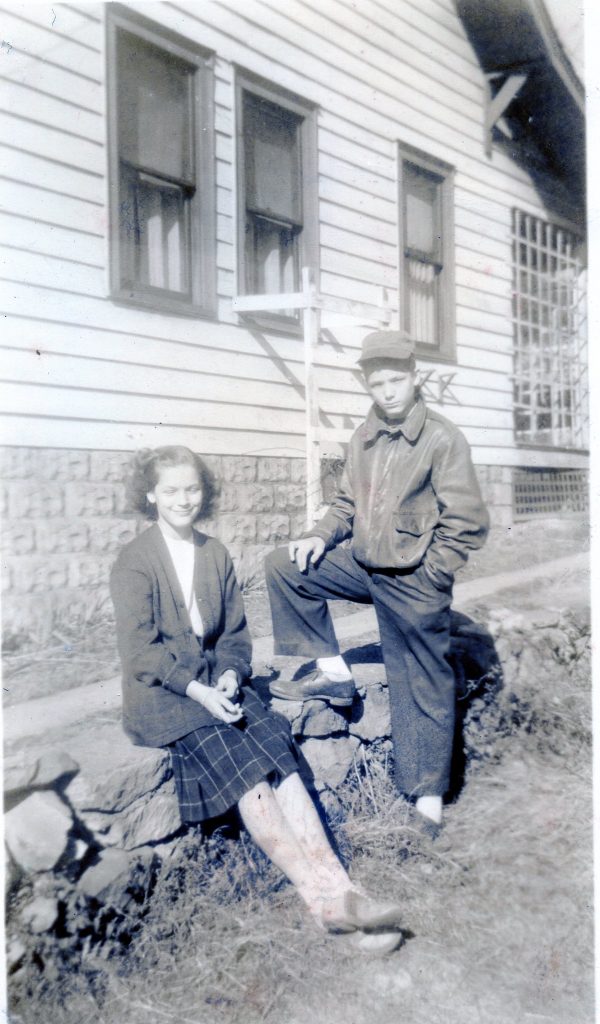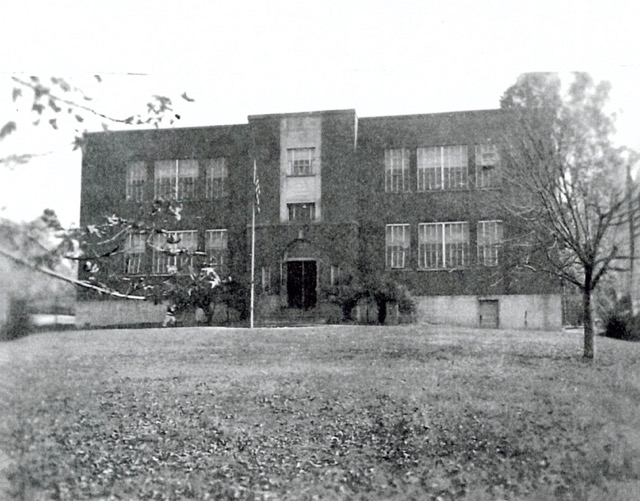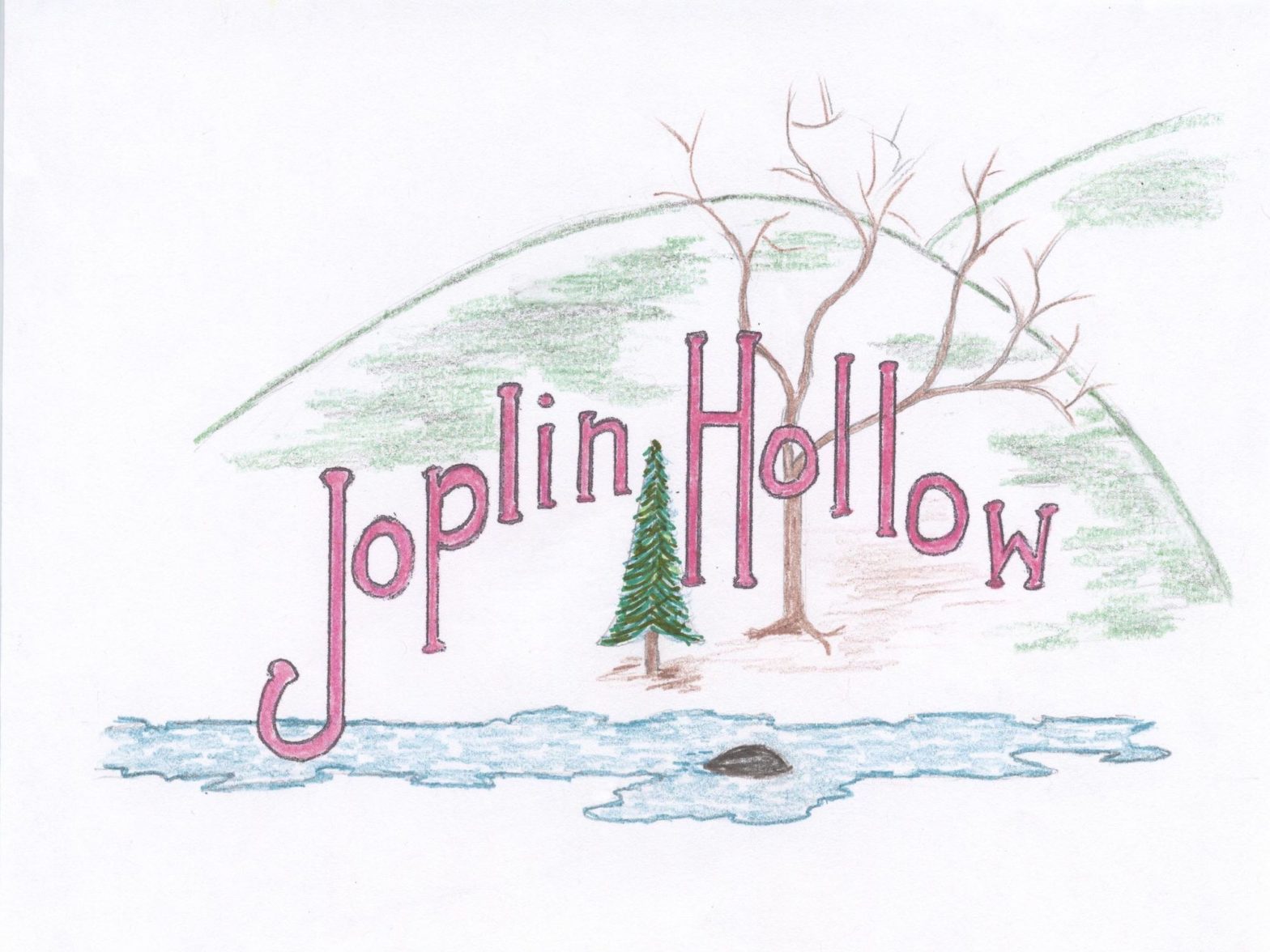I should say that these pages, in total, comprise a series of sketches, not a highly detailed family history. I’ve been intentionally brief on several topics; my real purpose is to give you a profile, not an in-depth report. So as you read, do so with the knowledge that these are the “high spots” in my memories — hopefully just enough for you to get a fair understanding of who we were.
This entry is about just what the title says: my earliest personal memories. I have just a few memories of my very early years: When I was two-three, we lived in a “company house,” as did most coal mine families in those days. The company provided the homes (I think they charged rent, in the form of scrip), they were all built on the same plan, they all looked just alike. Tiny, frame structures. I have no specific memory of the layout of that house, but I do remember, of all things, a door knob. It was white, ceramic. And I remember a small refrigerator with a round motor on top. I also remember my father at that time. He worked at night — the “hoot owl” shift, and he would light his carbide lamp (which was mounted on his cap) before he left the house for work. I remember his showing me how he struck the flint that lighted the lamp, and the live flame that resulted. As best I can tell, I was two.
I know that “carbide lamp” is foreign to you, so look it up. These lamps were the state of the art in the early twentieth century; before that miners had very small oil lamps with wicks, that looked like very small pitchers and hooked onto their hats. Carbide lamps were fueled by calcium carbide, which formed acetylene gas when mixed with water. The lamp fed water into the carbide ‘rocks,’ pushing gas into an orifice and then lighted by a spark created by a metal wheel scraped against flint. Got that? No? Look it up.
Another two-three-year-old memory: Alice, my twin sister and I were trained to use a small toilet “potty” which was white and had a red handle, and a red rim around the edge. Mother had her hands full: Dave, who was seven, along with the two of us, were full-time. She taught Alice and me to take care of each other in small ways; in this instance, we would take turns on the potty. While she sat, I would turn around and she would undo the buttons that kept my shirt and pants together.
Then it was my turn to sit. And I remember that.
Bet you’re thinking “I don’t think I’d’ve told that.” Well, I just did.
When my mother (as I learned later) told Dad that she was NOT going to raise her family in a forlorn coal camp, and for him to get another job, mother and we kids moved in with Dad’s parents in Alderson while Dad went to the Kanawha Valley to find work. This was in the middle of the depression and jobs were virtually nonexistent. I remember very vaguely that year in Alderson; Alice and I were three. In addition to my grandparents, great-grandmother Mammaw was there, as was my aunt Ruth, who was a teenager. I remember Ruth in her high school band uniform — maroon and white. She played clarinet. Ruth is about 90 now, and I’ve seen her at her Florida home a couple of times in recent years. She was and is a beautiful, good-natured, funny, good-hearted person.

Back to Alderson. I remember a dark closet beneath the staircase, with a door. I think it was used for kitchen storage — food, or pots and pans. Once as I started to open the closet door, Mammaw barked at me, “Don’t you dare! There are goblins in there!” I had no idea what goblins were, but no matter — Mammaw knew how to frighten a little kid.
Sometime during that year, Dad was lucky enough to get a job with Carbide and Carbon Chemicals Corporation — CCCC, in South Charleston, WV. He told me later that the line to the personnel office stretched down the highway for more than a mile — that got my attention; with unemployment at that level, it was miraculous that he was hired. (CCCC later became Union Carbide, an internationally famous chemical company.) On my and Alice’s fourth birthday we moved to South Charleston, into a tiny house on Franklin Terrace, which was part of the old Kanawha Turnpike, and was on a hillside overlooking the Carbide plant, which was on the riverbank. The exterior of the house was brown; there were two bedrooms. During our time there Dad’s brother Paul and Mom’s brother Christy both came to stay with us and get jobs at Carbide. Counting Paul and Christy, there were seven of us in that tiny house. I have no idea where we slept. But I do remember a green daybed in the living room, and I remember playing with Alice in the side yard, rubbing pieces of soft sandstone against a piece of screen wire, making what we called “brown sugar.”
We were about four. By today’s standards we were living in poverty. By Great Depression standards we were among the fortunate: Dad had a job. But we barely made it — nothing to spare.
I’m sure you’re getting it: these memories are for the most part absolutely unimportant and unremarkable. But they’re mine, so I suppose they are part of who I am. And except for the Mammaw episode, all my memories of those early years are very happy. I think that’s so because mother was a comforting, encouraging person, who didn’t show the troubled face that comes with poverty, hard times, and hopelessness. Dad was a worrier, taciturn, and stern. But caring, too. He worked shift work at the plant for thirty-six years, being rarely at home during “regular” hours, so our main parental contact was with our mother.

Franklin Terrace was a grimy place. Across the road and down at the bottom of the hill was the railroad, with coal-fired steam engines spewing black smoke and cinders as they worked in the freight yard. On the other side of the railroad was the highway, and then, across the highway was the Carbide plant, which belched fumes beyond description from its stacks. I can remember the pervasive, nose-burning odors: oil, coal, gas, chemicals, traffic: all in combination to produce a lingering heaviness and a stench which can be neither described nor replicated.
We lived at Franklin Terrace until September 1937, when my parents rented a larger home nearby, but away from the plant and railroad. The house was at 123 Sycamore Street, and Alice and I were so proud that our address was 123 — one, two, three. We moved in on the first day of school for the two of us. So that day in 1937 was a really big deal — we walked — with Mom — to Zogg O’Dell Elementary School from one house, and walked home from school to another house. You guessed it: Alice and I thought we were the most unique kids in South Charleston: who else had possibly had that experience? That rented house was home to Mom and Dad until they finally built a home on Coal River in St. Albans in 1961. I recall that the rent at some point was twenty-five dollars a month. The Sycamore Street house was a frame two story house with two original bedrooms upstairs and a downstairs bedroom which was actually a converted kitchen, about 8‘X10’.

My childhood there was full of joy, and no one ever gave our crowded quarters a second thought. Over time, we had as part of the extended family uncles Paul and Christy, aunts Rook and Edith, Uncle and Aunt Dick Zopp and Ruth (Farley), along with infant Carolyn; a family friend named “Cotton” White, a cousin Ed Hale, and, of course, Nanny Farley (Lelia Hite), who stayed with us after granddad Farley died in 1945. Somehow, my mother saw to it that everyone was comfortable — and fed. So it seemed there was a steady stream of “room and boarders,” they would stay for two-three years until they got established with work, and enough ahead to find another place to live. I don’t remember any friction within the household; it was just accepted as our normal lifestyle. I liked all those people, they were friendly, and they were family. We got along just fine. Looking back, I’m without words to say how Mom did it: washing and drying clothes for that gang. Cooking, packing lunches for three, four or more workers, taking care of three kids, cleaning house (no vacuums, dishwashers, etc. in those days), and the rest. I don’t remember any of the men pitching in — I guess back then that the division of labor was based on a different standard.
First grade was exciting — just being in school, getting to know other kids, going to the playground for recess, eating lunch from home at our desks, and the rest. Our teacher was “Missis” Shaffer, as we all called her, who was kind. I don’t know if we learned anything at all — curriculum-wise, that is; maybe how to read a little. But we had already memorized the alphabet and numerals 1 through 10 from the red and blue letters and numbers on the edges of our cereal bowls. The principal was Miss Pearl Wheeler, a cranelike, stern, bony lady of about 40, so we thought she was probably about 80. I never heard her say one word. Never saw her smile. And being the principal, she was uniformly disliked and feared by all. Who knows? She could have been — probably was — an okay person. But even today, I secretly doubt it.
In the second grade I fell in love with Maggie Triplett; she lived close by, had golden hair and a big smile with a gap between her front teeth, and we were in the same classroom. I think it was the smile that got me. But she never showed any interest in me at all; her dreamy eyes were always somewhere else. So that was that; I think my love life with her lasted a week or so. After that I didn’t think much about girls until much later, maybe when I was about thirteen, when I fell in love with my history teacher — I don’t remember her name, but she sure was nice to me. And pretty. Every day I left her class with my mind unable to see or comprehend anything other than my romantic fantasies of the two of us, looking at each other, never kissing.

Going back a little: when we entered the third grade, the school was so crowded they decided to “double promote” some of us to make more room the coming year. Alice and I, along with about fifteen other kids in our class, completed the third grade in one semester, thus becoming “double promoted.” That meant we started the fourth grade in January, and it stayed that way until we graduated — one semester early — from high school. There’s no doubt this caused scheduling problems at our schools, and besides, we in all likelihood didn’t actually complete that third grade stuff. Anyway, it worked out OK; Alice and I stayed an extra semester in high school as “post graduates” and finished with our original class. In the end, it didn’t matter. Just caused scheduling problems for the administrators. I could pass along a few more lines about all this, but somewhere “early memories” become not so early, so I’ll let it go at that. The memory gap between this and other entries is between the ages 8 and 11 — so you’ll see me beginning at age 11 in other writings.


You must log in to post a comment.